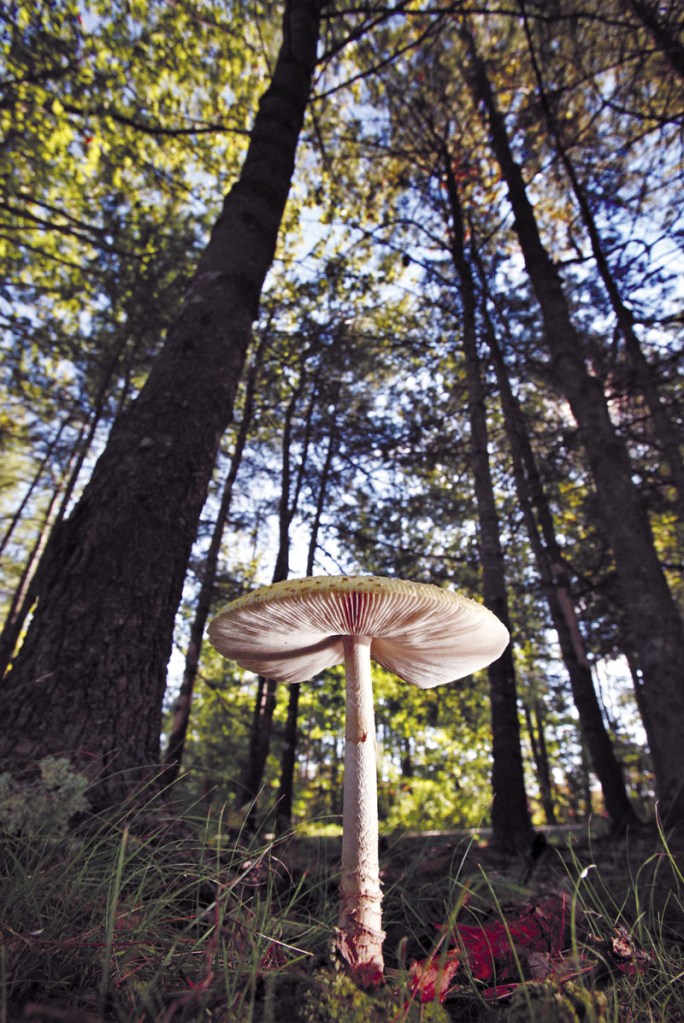PORTLAND — The tropical storms that drenched the Northeast this year left an unexpected bounty: Thousands of mushrooms have sprung up on some lawns, and foragers have filled bags with wild ones plucked from the earth, stumps and logs.
“It was like a scene from ‘Alice and Wonderland,'” said David Fischer, who wrote “Edible Wild Mushrooms of North America.”
The mushrooms are providing good meals for people like Margaret Primack of Newton, Mass., who collected 60 to 70 pounds this summer. But because some mushrooms are poisonous, they also present a danger for people who can’t tell the difference between the tasty and the toxic.
The Northern New England Poison Center has seen an increase in mushroom poisoning cases in Maine, New Hampshire and Vermont, with 97 in August and September, nearly double the figure from the same time last year.
“People need to have respect for mushrooms,” said Karen Simone, the poison center’s director. “They don’t understand that this can be dangerous.”
Different mushrooms types can look similar, and it takes a trained eye to tell the difference between those that are safe and those that are deadly. Mushroom and health experts discourage people from eating wild mushrooms unless they’re absolutely sure they’re safe.
“If somebody eats the wrong thing, they could be dead, and it’s not a fun way to go,” said Fischer, who also runs a website dedicated to wild mushrooms from his home in Syracuse, N.Y.
Consumers who are worried about safety can buy mushrooms from the nation’s commercial growers, who produce the white button mushrooms commonly used on salads and pizzas, along with shiitake, Portobello and oyster mushrooms.
Commercial mushroom production also is up, topping $1 billion for the first time in the 2010-11 growing season, according to the U.S. Department of Agriculture. That’s an 8 percent increase from the previous year. Pennsylvania is the leading mushroom state, producing more than half of the nation’s commercial crop.
Mushrooms thrive in wet weather and there’s been no shortage in the Northeast. Most of the region had more rain than usual in August and September, with cities like Baltimore, New York and Philadelphia setting two-month records. Almost 30 inches of rain were recorded in New York’s Central Park during that time.
The downpour didn’t help spring mushrooms like morels, but it boosted other species like black trumpets, chanterelles and hen-of-the-woods, which can weigh 20 to 30 pounds each. Hundreds of common mushrooms, and sometimes more, appeared on lawns and golf courses.
“This has been a special year. Some people say it’s the best that they’ve ever seen,” said Cynthia Kowal, a senior research administrator at Boston University, member of the Boston Mycological Society and amateur forager who collects mushrooms in Maine, New Hampshire and Massachusetts.
Mycology is the study of fungi. Both amateur and professional mycologists tend to be a passionate group, photographing and documenting mushrooms, sharing and identifying them and discussing them in online forums.
This year, the volume and variety of mushrooms has given them plenty to talk about. There are lobster mushrooms, so-called because of their red color; shaggy manes, an edible lawn mushroom; stinkhorn mushrooms, which emit an unpleasant odor; and chanterelles, prized among epicureans.
Candice Heydon, a mushroom grower and broker in Maine, said she has had to turn away amateur pickers and foragers who’ve shown up at her door with bags of mushrooms, hoping to make some extra money.
Even some professional foragers have been overwhelmed.
“They’re looking for one kind they’re going to get paid for. When they see so many, they’re distracted,” said Heydon, who owns Oyster Creek Mushroom Co. in Damariscotta.
David Spahr, who collects and studies mushrooms, said the volume of black trumpets is the biggest he’s seen in 40 years of foraging.
“That gets people excited because black trumpets are the best-tasting mushrooms in the woods,” he said from his home in Washington, Maine.
Spahr cautioned that it’s not just rain that’s responsible for the widespread fungi this summer and fall. Mushrooms are a bit of a mystery and are not well understood, he said, and even experts don’t fully understand why some years are better than others.
That’s no concern for Primack, a middle school teacher, and her husband, Richard. They’re just grateful for the bounty they’re enjoying this year.
“People normally add mushrooms as a garnish for dishes. This year they’re so abundant that we have whole large bowls of mushrooms for dinner,” said Richard Primack, a biology professor at Boston University. “Our freezer is filled with mushrooms. We’re having difficulty finding space for the ice cream.”
Send questions/comments to the editors.



Success. Please wait for the page to reload. If the page does not reload within 5 seconds, please refresh the page.
Enter your email and password to access comments.
Hi, to comment on stories you must . This profile is in addition to your subscription and website login.
Already have a commenting profile? .
Invalid username/password.
Please check your email to confirm and complete your registration.
Only subscribers are eligible to post comments. Please subscribe or login first for digital access. Here’s why.
Use the form below to reset your password. When you've submitted your account email, we will send an email with a reset code.